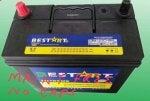4. CCA, CA, AH and RC. These are the standards that most battery companies use to rate the output and capacity of a battery.
Cold cranking amps (CCA) is a measurement of the number of amps a battery can deliver at 0°F for 30 seconds and not drop below 7.2 volts. So a high CCA battery rating is especially important in starting battery applications, and in cold weather.This measurement is not particularly important in deep cycle batteries, though it is the most commonly "known" battery measurement.
CA is cranking amps measured at 32°F. This rating is also called marine cranking amps (MCA). Hot cranking amps (HCA) is seldom used any longer but is measured at 80°F.
Reserve Capacity (RC) is a very important battery rating. This is the number of minutes a fully charged battery at 80°F will discharge 25 amps until the battery drops below 10.5 volts.
An amp hour (AH) is a rating usually found on deep cycle batteries. The standard rating is an amp rating taken for 20 hours. What this means for a 100 AH rated battery is this: Draw from the battery for 20 hours, and it will provide a total of 100 amp hours. That translates to about 5 amps an hour. (5 x 20 = 100). However, it's very important to know that the total time of discharge and load applied is not a linear relationship. As your load increases, your realized capacity decreases. This means if you discharged that same 100 AH battery by a 100 amp load, it will not give you one hour of runtime. On the contrary, the perceived capacity of the battery will be that of 64 amp hours.






